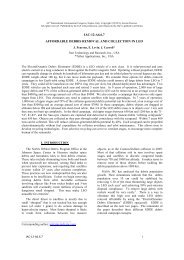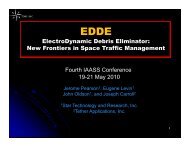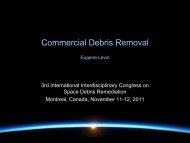The Cost of Future Collisions in LEO - Star Technology and Research
The Cost of Future Collisions in LEO - Star Technology and Research
The Cost of Future Collisions in LEO - Star Technology and Research
You also want an ePaper? Increase the reach of your titles
YUMPU automatically turns print PDFs into web optimized ePapers that Google loves.
28<br />
Appendix B<br />
DISTRIBUTION OF FRAGMENTS BY MASS<br />
<strong>The</strong> total estimated number <strong>of</strong> the Fengyun-1C <strong>and</strong> Cosmos-Iridium fragments<br />
left <strong>in</strong> orbit long enough to be observed can be derived from the NASA data [14,15].<br />
<strong>The</strong> total mass <strong>of</strong> the three satellites was 2336 kg. This gives the average yield <strong>of</strong><br />
fragments per kilogram <strong>of</strong> the source mass shown <strong>in</strong> Table B1.<br />
Table B1. Fengyun-1C, Cosmos-2251,<br />
<strong>and</strong> Iridium-33 fragments<br />
Size Count Yield<br />
Over ∼0.5 cm ∼ 1.3 · 10 6 ∼560/kg<br />
Over ∼2 cm ∼ 1.1 · 10 5 ∼47/kg<br />
Over ∼10 cm 4680 2/kg<br />
Now, we need to estimate the mass distribution, because the fragment mass<br />
is the primary factor determ<strong>in</strong><strong>in</strong>g the impact damage to satellites. <strong>The</strong> fragments<br />
smaller than ∼10 cm (“shrapnel”) are currently untracked, <strong>and</strong> their mass-to-area<br />
distributions are uncerta<strong>in</strong>. As the track<strong>in</strong>g capabilities improve, we will know<br />
more about the physical properties <strong>of</strong> the shrapnel, but at this time, we have to<br />
base estimates on ground tests <strong>and</strong> limited orbital data.<br />
For the purpose <strong>of</strong> future damage assessment, we are most <strong>in</strong>terested <strong>in</strong> a<br />
narrow range between 0.3 <strong>and</strong> 3 g with<strong>in</strong> the context <strong>of</strong> a wider range between 0.1<br />
<strong>and</strong> 50 g. For this range, we will assume a power-law distribution<br />
κ m = κ c (m c /m) γ ,<br />
(B1)<br />
where κ m is the yield <strong>of</strong> fragments with masses larger than m produced on average<br />
<strong>in</strong> a catastrophic collision per unit mass <strong>of</strong> the source object, m c is a characteristic<br />
mass, γ > 0 is the exponent, <strong>and</strong> κ c is the yield <strong>of</strong> fragments heavier than m c .<br />
When γ ≠ 1, the fraction <strong>of</strong> the total mass <strong>of</strong> the source object accumulated<br />
<strong>in</strong> orbit<strong>in</strong>g fragments with masses between m 1 <strong>and</strong> m 2 is calculated as<br />
η =<br />
∫ κ1<br />
κ 2<br />
m dκ m = γ<br />
1 − γ (κ 2m 2 − κ 1 m 1 ), (B2)<br />
where κ 1,2 = κ m (m 1,2 ). When γ = 1, the fraction <strong>of</strong> mass <strong>in</strong> this range is equal to<br />
η 1 = κ c m c ln(m 2 /m 1 ).<br />
(B3)<br />
For our purposes, we set m c = 1 g, m 1 = 0.1 g, <strong>and</strong> m 2 = 50 g.








